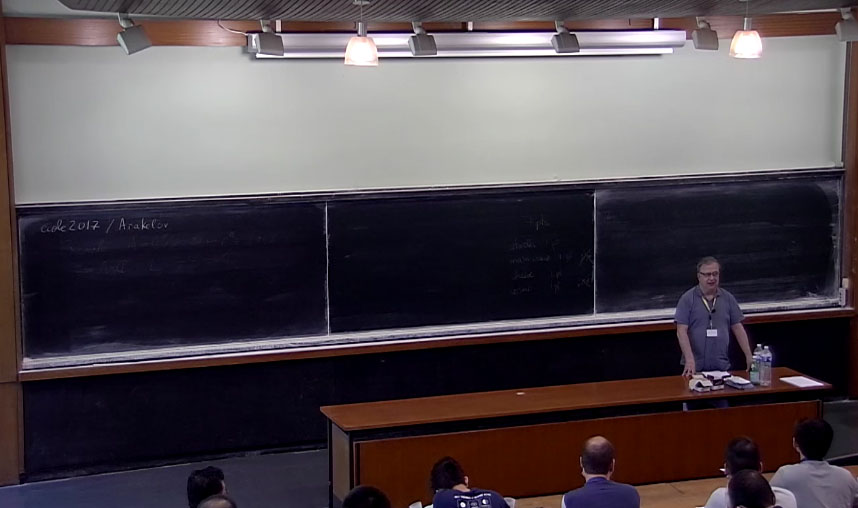Notice
P. Salberger - Quantitative aspects of rational points on algebraic varieties (part4)
- document 1 document 2 document 3
- niveau 1 niveau 2 niveau 3
Descriptif
Let X be a subvariety of Pn defined over a number field and N(B) be the number of rational points of height at most B on X. There are then general conjectures of Manin on the asymptotic behaviour of N(B) when B goes to infinity. These conjectures can be studied using the Hardy-Littlewood method for non-singular complete intersections of high dimensions and by adelic harmonic analysis for varieties related to algebraic groups. But for most varieties there are no other methods available apart from sieve theory and determinant methods. The latter was first developed for affine plane curves in a paper of Bombieri-Pila and extended to projective varieties by Heath-Brown and myself. The goal of the p-adic version of this method is to show that the set of rational points of height at most B on X in a congruence class satisfy further equations if p is large enough compared to B. One can then proceed by induction with respect to dim(X) to obtain uniform upper estimates for N(B) like a proof of the dimension growth conjecture of Heath-Brown and Serre.
The lectures will focus on the determinant method. We will make essential use of Mumford’s geometric invariant theory too see how stability conditions affect the equidistribution of rational points. This is inspired by Donaldson’s and Tian’s theory of Kähler-Einstein metrics. We will also explain how one can use the theory of volumes of line bundles in Lazarsfeld’s book to improve upon the original bounds of Heath-Brown. If time permits we will also mention a number of striking similarities between the determinant method and methods used in the theory of Diophantine approximation.
Dans la même collection
-
X. Yuan - On the arithmetic degree of Shimura curves
YuanXinyiThe goal of this talk is to introduce a Gross--Zagier type formula, which relates the arithmetic self-intersection number of the Hodge bundle of a quaternionic Shimura curve over a totally real
-
A. von Pippich - An analytic class number type formula for PSL2(Z)
PippichAnna-Maria vonFor any Fuchsian subgroup Γ⊂PSL2(R) of the first kind, Selberg introduced the Selberg zeta function in analogy to the Riemann zeta function using the lengths of simple closed geodesics on Γ∖H
-
Y. Tang - Exceptional splitting of reductions of abelian surfaces with real multiplication
TangYunqingChavdarov and Zywina showed that after passing to a suitable field extension, every abelian surface A with real multiplication over some number field has geometrically simple reduction modulo p
-
Z. Huang - Diophantine approximation and local distribution of rational points
HuangZhizhongWe show how to use the recent work of D. McKinnon and M. Roth on generalizations of Diophantine approximation to algebraic varieties to formulate a local version of the Batyrev-Manin principle on
-
C. Soulé - Arithmetic Intersection (Part4)
SouléChristopheLet X be a 2-dimensional, normal, flat, proper scheme over the integers. Assume ¯L and ¯M are two hermitian line bundles over X. Arakelov (and Deligne) defined a real number ¯L.¯M, the arithmetic
-
C. Soulé - Arithmetic Intersection (Part1)
SouléChristopheLet X be a 2-dimensional, normal, flat, proper scheme over the integers. Assume ¯L and ¯M are two hermitian line bundles over X. Arakelov (and Deligne) defined a real number ¯L.¯M, the arithmetic
-
C. Soulé - Arithmetic Intersection (Part3)
SouléChristopheLet X be a 2-dimensional, normal, flat, proper scheme over the integers. Assume ¯L and ¯M are two hermitian line bundles over X. Arakelov (and Deligne) defined a real number ¯L.¯M, the arithmetic
-
C. Soulé - Arithmetic Intersection (Part2)
SouléChristopheLet X be a 2-dimensional, normal, flat, proper scheme over the integers. Assume ¯L and ¯M are two hermitian line bundles over X. Arakelov (and Deligne) defined a real number ¯L.¯M, the arithmetic
-
D. Loughran - Sieving rational points on algebraic varieties
LoughranDanielSieves are an important tool in analytic number theory. In a typical sieve problem, one is given a list of p-adic conditions for all primes p, and the challenge is to count the number of integers
-
P. Salberger - Quantitative aspects of rational points on algebraic varieties (part2)
SalbergerPerLet X be a subvariety of Pn defined over a number field and N(B) be the number of rational points of height at most B on X. There are then general conjectures of Manin on the asymptotic behaviour
-
E. Peyre - Slopes and distribution of points (part3)
PeyreEmmanuelThe distribution of rational points of bounded height on algebraic varieties is far from uniform. Indeed the points tend to accumulate on thin subsets which are images of non-trivial finite
-
P. Salberger - Quantitative aspects of rational points on algebraic varieties (part1)
SalbergerPerLet X be a subvariety of Pn defined over a number field and N(B) be the number of rational points of height at most B on X. There are then general conjectures of Manin on the asymptotic behaviour
Avec les mêmes intervenants et intervenantes
-
P. Salberger - Quantitative aspects of rational points on algebraic varieties (part3)
SalbergerPerLet X be a subvariety of Pn defined over a number field and N(B) be the number of rational points of height at most B on X. There are then general conjectures of Manin on the asymptotic behaviour
-
P. Salberger - Quantitative aspects of rational points on algebraic varieties (part1)
SalbergerPerLet X be a subvariety of Pn defined over a number field and N(B) be the number of rational points of height at most B on X. There are then general conjectures of Manin on the asymptotic behaviour
-
P. Salberger - Quantitative aspects of rational points on algebraic varieties (part2)
SalbergerPerLet X be a subvariety of Pn defined over a number field and N(B) be the number of rational points of height at most B on X. There are then general conjectures of Manin on the asymptotic behaviour
Sur le même thème
-
Tuan Ta Pesao : écritures de sable et de ficelle à l'Ile d'Ambrym
VandendriesscheEricCe film se déroule au Nord de l’île d’Ambrym, dans l’archipel de Vanuatu, en Mélanésie...
-
"Le mathématicien Petre (Pierre) Sergescu, historien des sciences, personnalité du XXe siècle"
HerléaAlexandreAlexandre HERLEA est membre de la section « Sciences, histoire des sciences et des techniques et archéologie industrielle » du CTHS. Professeur émérite des universités, membre effectif de l'Académie
-
Webinaire sur la rédaction des PGD
LouvetViolaineRédaction des Plans de Gestion de Données (PGD) sous l’angle des besoins de la communauté mathématique.
-
Alexandre Booms : « Usage de matériel pédagogique adapté en géométrie : une transposition à interro…
« Usage de matériel pédagogique adapté en géométrie : une transposition à interroger ». Alexandre Booms, doctorant (Université de Reims Champagne-Ardenne - Cérep UR 4692)
-
T. Ozuch - Noncollapsed degeneration and desingularization of Einstein 4-manifolds
OzuchTristanWe study the noncollapsed singularity formation of Einstein 4-manifolds. We prove that any smooth Einstein 4-manifold close to a singular one in a mere Gromov-Hausdorff (GH) sense is the result
-
D. Tewodrose - Limits of Riemannian manifolds satisfying a uniform Kato condition
TewodroseDavidPresentation of a joint work with G. Carron and I. Mondello where we study Kato limit spaces.
-
Y. Lai - A family of 3d steady gradient Ricci solitons that are flying wings
LaiYiWe find a family of 3d steady gradient Ricci solitons that are flying wings. This verifies a conjecture by Hamilton. For a 3d flying wing, we show that the scalar curvature does not vanish at
-
A. Mondino - Time-like Ricci curvature bounds via optimal transport
MondinoAndreaThe goal of the talk is to present a recent work in collaboration with Cavalletti (SISSA) on optimal transport in Lorentzian synthetic spaces. The aim is to set up a “Lorentzian analog” of the
-
M. Lesourd - Positive Scalar Curvature on Noncompact Manifolds and the Positive Mass Theorem
LesourdMartinThe study of positive scalar curvature on noncompact manifolds has seen significant progress in the last few years. A major role has been played by Gromov's results and conjectures, and in
-
R. Perales - Recent Intrinsic Flat Convergence Theorems
PeralesRaquelThéorèmes récents de convergence plane intrinsèque
-
J. Fine - Knots, minimal surfaces and J-holomorphic curves
FineJoëlI will describe work in progress, parts of which are joint with Marcelo Alves. Let L be a knot or link in the 3-sphere. I will explain how one can count minimal surfaces in hyperbolic 4-space
-
J. Wang - Topological rigidity and positive scalar curvature
WangJianIn this talk, we shall describe some topological rigidity and its relationship with positive scalar curvature. Precisely, we will present a proof that a complete contractible 3-manifold with


























